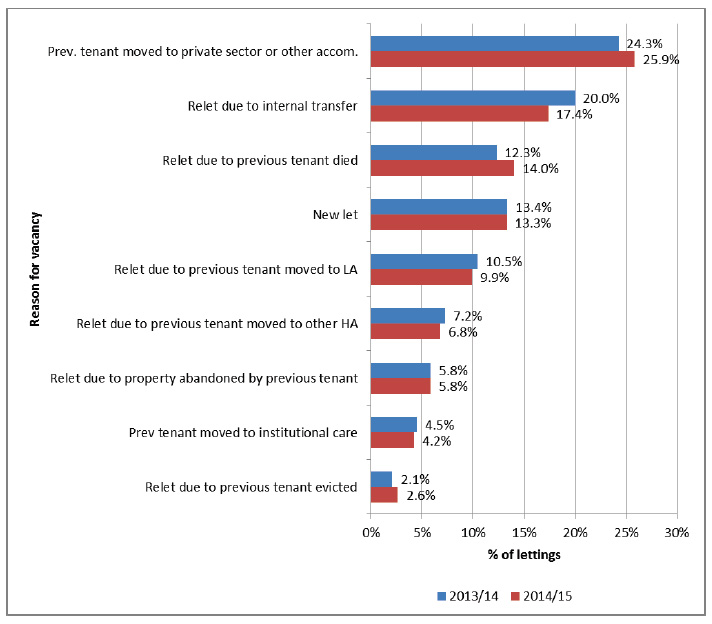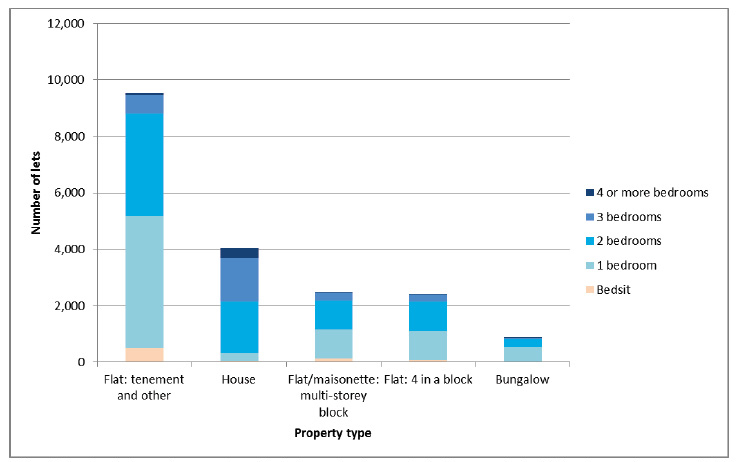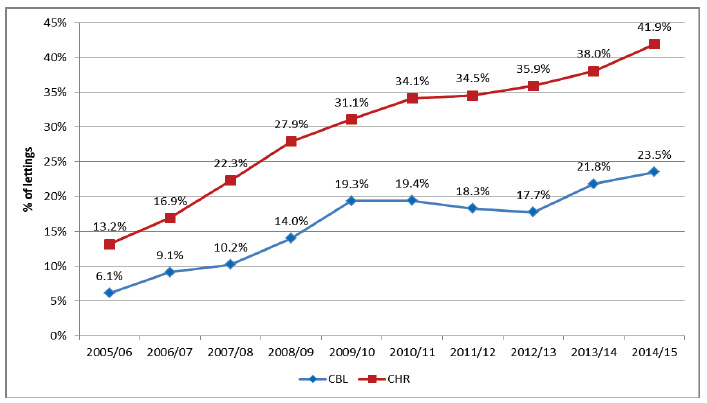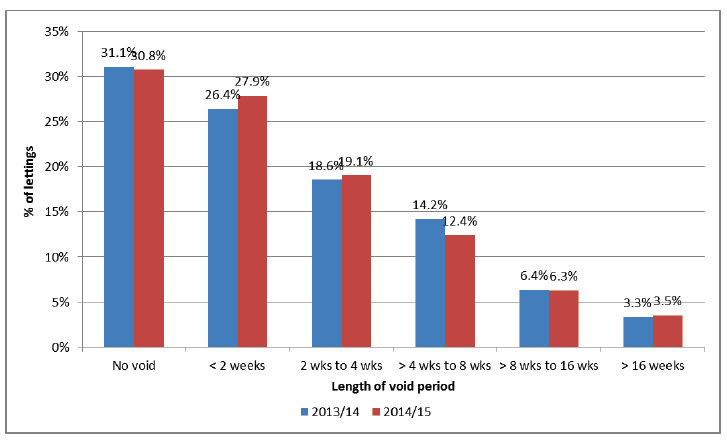SCORE Annual Summary Report 2014-15
SCORE is a collection of information from Registered Social Landlords about the new lets they make in a given year.
Building and Letting Types
Reason for Vacancy
Broadly speaking a property into which a household moves can either be a new let - meaning that the property is new and/or being let for the first time - or a re-let.
New lets accounted for 13.3% of all lets in 2014-15 - almost the exact same proportion as in 2013-14 (13.4%) which was itself the same as in 2012-13.
SCORE also collects information on the reasons that re-let properties into which households moved during the year were left vacant by their previous inhabitants.
Over a third of all vacancies (34.1%) were created from transfers within social housing (17.4% transferred to another property owned by the same RSL, 9.9% moved to a local authority owned house and 6.8% moved to a property owned by another RSL). This compares to 25.9% of vacancies arising from the previous tenant moving to private sector or other accommodation.
Chart 7: Reason for Property Vacancy

Dwelling Type and number of bedrooms
Chart 8 and table 2 show that almost three quarters (73.8%) of dwellings let out during the year were flats. Amongst these 12.7% of all properties were multi-story blocks, 12.3% were 4 in a block and almost half (48.8%) were tenements or some other type of flat not covered by the other categories.
Houses accounted for most of the remaining properties (around a fifth of all properties let during the year), bungalows made up a further 4.4% and other dwelling types accounted for the remaining 1.1% of all lettings. This last category is not shown in Chart 8 to aid clarity.
One bedroom (38.9%) and two bedroom (40.1%) properties together accounted for almost four-fifths of all properties let. Bedsit properties accounted for 4.4% of lettings, with a further 14.3% being 3 bedroom and 2.3% being 4 or more bedrooms. One bedroom flats accounted for over a third (34.4%) of total lettings for the year.
Chart 8: Dwelling type by number of bedrooms

Note: This chart shows the number of lets in each category but please note that this does not represent all lets in Scotland.
Table 2: Dwelling types and number of bedrooms, 2013-14 and 2014-15
| 2013/14 |
2014/15 |
|
|---|---|---|
| Dwelling Type |
||
| Flat: tenement and other |
49.6% | 48.8% |
| House |
22.4% | 20.6% |
| Flat/maisonette: multi-storey block |
11.3% | 12.7% |
| Flat: 4 in a block |
11.2% | 12.3% |
| Bungalow |
4.5% | 4.4% |
| Other |
1.1% | 1.1% |
| Total |
100.0% | 100.0% |
| Number of bedrooms |
||
| Bedsit |
5.7% | 4.4% |
| 1 bedroom |
37.2% | 38.9% |
| 2 bedrooms |
40.4% | 40.1% |
| 3 bedrooms |
14.0% | 14.3% |
| 4 or more bedrooms |
2.7% | 2.3% |
| Total |
100.0% | 100.0% |
Design Type
A property may be designed for general purpose use or, alternatively, for a specific housing group, such as older people.
The majority of properties let during 2014-15 were general purpose dwellings (85.0%). Housing specifically designed for older people accounted for 13.8% of lettings. Within this 10.0% were sheltered properties - these provide a number of features in addition to the standards for general needs housing (such as an emergency call service and possibly a warden). A further 3.8% were amenity or alarm properties which are either similar to sheltered housing but without the warden or are not adapted but have a community alarm.
Table 3: Design type, 2013-14 and 2014-15
| 2013/14 |
2014/15 |
|
|---|---|---|
| Amenity/Alarm |
3.7% | 3.8% |
| Sheltered/Warden |
8.9% | 10.0% |
| General purpose |
86.4% | 85.0% |
| Shared Living |
0.4% | 0.4% |
| Other |
0.6% | 0.8% |
CHR (Common Housing Register) and CBL (Choice Based Lettings)
CHR (Common Housing Register)
A Common Housing Register (CHR) is where Local Authorities and some (or all) housing associations in the area share a single housing list meaning that a household may be allocated to the housing of any participating social landlord. In 2014-15 over two-fifths (41.9%) of households housed obtained their tenancy through a CHR - a 3.9 percentage point increase from 2013-14. This continues the increasing trend in the proportion of households allocated in this way (see Chart 9).
CBL (Choice Based Lettings)
Choice Based Lettings (CBL) is a type of allocation system which allows households to actively apply for properties that match their assessed requirements. Around a quarter (23.5%) of households used a CBL allocation system in 2014-15 - a 1.7 percentage point increase on the 21.8% in 2013-14. As chart 9 shows the proportion of lettings allocated in this way has generally been on the increase.
Chart 9: CHR and CBL lettings, 2005/06 to 2014/15

Void Length
The void period of a property is the period for which it was available for letting but did not have a tenant (i.e. generally the period between the previous let ending and the current one beginning). The void period is derived from the tenancy start date, the vacancy date and, if applicable, the repair completion date provided by the housing association. Details of the calculation are included in the Annex.
Around 3 in 10 properties (30.8%) let during the year were let immediately after the previous tenants vacated the property or immediately after the conclusion of any major repair works being carried out on the property. This was similar to 2013-14 (31.1%) but down from 33.9% in 2012-13 and from 37.0% in 2011-12. Over two-fifths of properties (41.3%) were void for two weeks or more, down slightly from 42.5% in 2013-14.
The average time for which a property was vacant between the end of one tenancy and the start of the next was 24 days, three days less than in 2013-14.
Chart 10: Void length of property, 2013/14 and 2014/15

Contact
Email: Andrew White
There is a problem
Thanks for your feedback